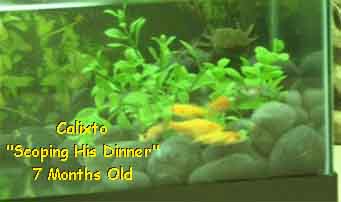index[Calixto][Axolotl FAQ]  [Description] [My Axolotls] [Habitat] [Feeding] [Health] [References] [Links] [Genetics] contact-or- Sign The Guestbook version98.12.02visitstravelDa Homepagelegal© 1996-1998Chris Eng All Rights Reserved 
|
How Do They Find Their Food?Axolotls find there food by smell and by their lateral line organs, which are sensory organs located along the sides of their head and trunk. Axolotls have weak eyesight and they do not seem to be used for finding food. Their lateral line organs detect motion and pressure. When food is dropped from the top, they use their lateral line organs and sense of smell to located the food. If they happen to miss it, they will usually use their nose to find food on the bottom of the tank. Non-live food should be siphoned or netted out at the end of each day as not to spoil the water. It is important to note that axolotls will eat or try to eat anything that is put in front of their faces.FeedingJuveniles should be fed every day with Artemia and adults every other day with fish pellets, guppies, worms, or whatever you choose. Adults can survive on once to thrice a week feedings. Some axolotls have different metabolisms and might not eat for months and survive and even not exhibit any weight loss. Before you feed your axolotl, make sure it's awake by lightly tapping its container or turning on the lights or something that will solicit a reaction.Pelleted or Frozen FoodOverfeeding is not a known problem with axolotls, but make sure you clean-up any uneaten food immediately. I mainly feed my axolotls soft ground pellets made of fish. They are very odoriferous and soft so they can sense them easily. They are soft and sinkable, which are the key elements. When the food falls near them they open their mouth (Ambystoma means cup-mouth in latin) and sucks the food in. They grip the food with their tiny teeth while they bolt the food into their mouths. They can be trained to be fed in a certain area for easy cleanup. I always leave a colony of guppies (for the juveniles) or goldfish (for the adults) in the axolotl tank, just in case someone needs a late-night snack.Live FoodMy axolotls love tubifex worms, they are a special treat you should offer them occassionally. I would not put the worms in a tank with gravel or rocks, since they tend to hide between them. You can also transfer your axolotl to a clean container for feeding. My axolotls show no mercy when they sense live food, be it a guppy or a worm. Brine shrimp are good for juvenile axolotls, but tend to be messy and foul up the water since they are raised in salt-water. They only last a few hours in a fresh water tank, so take heed if you use them. Goldfish are harder for the axolotls to catch than a guppy. However, small goldfish turn into big goldfish if uneaten, and I usually have to feed the uneaten big fish to the turtles.When You Are AwayGuppies are perhaps the best companions and food source for the axolotls. They will not attack the axolotl, and they usually stay in the upper water column. The axolotls will either float to the top and wait for them, or they will patiently wait for the guppies to swim on by. They are an excellent way to feed your axolotl if you go on vacation and cannot feed them fish pellets.Problems With Live FoodWhen you buy live food at a store, you are unsure of what else you are getting. I have attributed fungal infections and bacterial infections on my axolotls from the tubifex worms, goldfish, and guppies I have purchased. My precautions are to thoroughly rinse the food and keep them in a holding tank for a few days before I give them to the ajolotes. If anyone has any other suggestions to ensure clean food, drop me a line! |
 
|